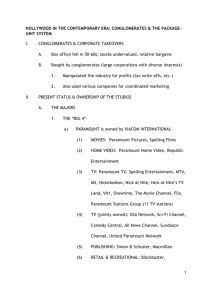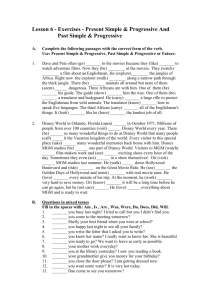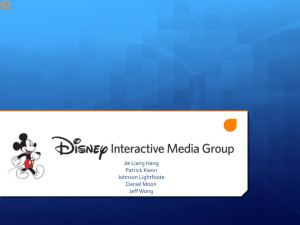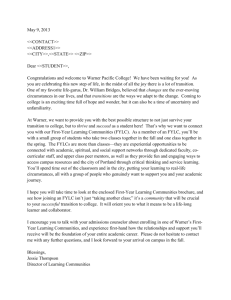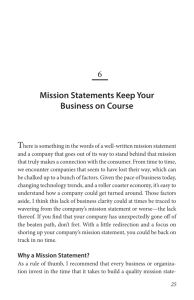the new world order: the major studios & conglomeration
advertisement
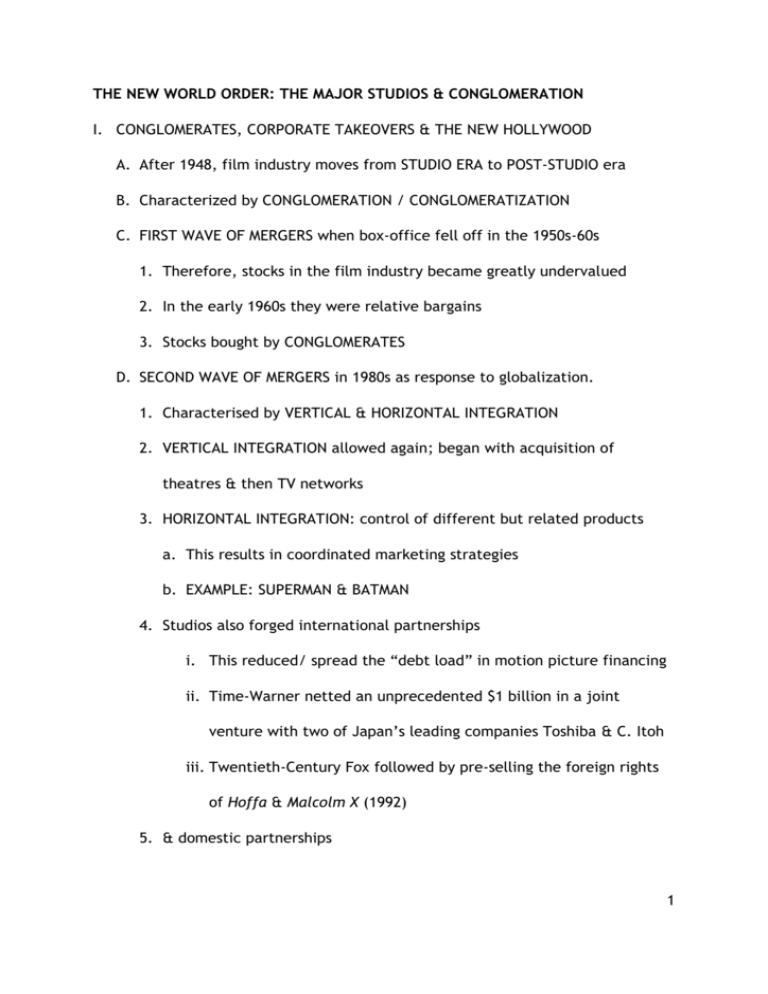
THE NEW WORLD ORDER: THE MAJOR STUDIOS & CONGLOMERATION I. CONGLOMERATES, CORPORATE TAKEOVERS & THE NEW HOLLYWOOD A. After 1948, film industry moves from STUDIO ERA to POST-STUDIO era B. Characterized by CONGLOMERATION / CONGLOMERATIZATION C. FIRST WAVE OF MERGERS when box-office fell off in the 1950s-60s 1. Therefore, stocks in the film industry became greatly undervalued 2. In the early 1960s they were relative bargains 3. Stocks bought by CONGLOMERATES D. SECOND WAVE OF MERGERS in 1980s as response to globalization. 1. Characterised by VERTICAL & HORIZONTAL INTEGRATION 2. VERTICAL INTEGRATION allowed again; began with acquisition of theatres & then TV networks 3. HORIZONTAL INTEGRATION: control of different but related products a. This results in coordinated marketing strategies b. EXAMPLE: SUPERMAN & BATMAN 4. Studios also forged international partnerships i. This reduced/ spread the “debt load” in motion picture financing ii. Time-Warner netted an unprecedented $1 billion in a joint venture with two of Japan’s leading companies Toshiba & C. Itoh iii. Twentieth-Century Fox followed by pre-selling the foreign rights of Hoffa & Malcolm X (1992) 5. & domestic partnerships 1 II. PRESENT STATUS & OWNERSHIP OF THE STUDIOS A. THE MAJORS 1. THE “BIG 4” (of which Paramount & Warner are more important) a. PARAMOUNT is now owned by VIACOM INTERNATIONAL i. MOVIES: Paramount Pictures, Spelling Films ii. HOME VIDEO: Paramount Home Video, Republic Entertainment iii. TV a) Paramount Television, Spelling Entertainment, MTV, M2, Nickelodeon, Nick at Nite, Nick at Nite’s TV Land, VH1, Showtime, The Movie Channel, Flix, Paramount Stations Group (11 TV stations) b) Jointly owned: USA Network, Sci-Fi Channel, Comedy Central (South Park, released by Paramount), All News Channel, Sundance Channel, United Paramount Network iv. PUBLISHING: Simon & Schuster, Macmillan v. RETAIL & RECREATIONAL: Blockbuster, Paramount Parks (6 theme parks), Theaters (Famous Players, United Cinemas International & Cinamerica), Bubba Gump Shrimp Restaurants vi. MISC: Viacom Consumer Products (Paramount toys, t-shirts, games), Viacom Entertainment Stores, Hamilton Projects (Spelling stuff), Famous Music publishers, Viacom Interactive Services b. WARNER BROS. 2 i. Merged with AOL in 1999 to form AOL-TIME-WARNER a) Merged with Kinney National Services in 1969 & TIME, Inc. to form TIME-WARNER in 1989 b) 1996, bought Turner Entertainment,libraries of MGM, UA, RKO ii. TIME INC. a) MAGAZINES: Time, Fortune, Life, Sports Illustrated, Money, People, Entertainment Weekly, Southern Living, Progressive Farmer, Weight Watchers, Asiaweek... b) BOOKS: Time Life, Book-of-the-Month Club, Little, Brown & Co, Warner Books, Oxmoor House... c) OTHER PUBLISHING OPERATIONS: Road Runner, Time Distribution Services, Warner Publisher Services, American Family Publishers, Pathfinder... iii. WARNER BROS. a) MOVIES & TV: Warner Bros., Warner Bros. TV, WB TV Network, Warner Bros. TV Animation, Hanna-Barbera Cartoons, Telepictures Productions, Witt-Thomas, Warner Bros. International TV, Castle Rock b) TIME WARNER CABLE: Full Service Network, NY1, Road Runner, West Valley Studios, Primestar... c) STORES: Warner Bros. Studio Stores, HBO Stores d) WARNER MUSIC GROUP: The Atlantic Group, Elektra 3 Entertainment Group, Warner Bros. Records, Warner Music International, Warner/Chappell Music, WEA Inc, Ivy Hill Corporation, Reprise Records, Discovery Records, Rhino Records, Columbia House Records, Warner Music Canada e) OTHER OPERATIONS: WB Domestic Pay-TV, Cable & Network Features, Warner Home Video, WB International Theatres, WB Consumer Products, WB Recreation Enterprises (Six Flags theme parks), DC Comics, Mad Magazine, WB Online iv. HOME BOX OFFICE: HBO, Cinemax, HBO Pictures/HBO Showcase, HBO Independent Productions, HBO Downtown Productions, HBO Animation, HBO Home Video, HBO Sports, Time Warner Sports, HBO En Español, Cinemax Selecciones, HBO Brasil, HBO Hungary, HBO Asia, HBO Poland, HBO Home Satellite... v. CNN: CNN, CNN International, Headline News, CNN en Espanol, CNN Airport Network, CNNRadio vi. TURNER ENTERTAINMENT NETWORKS: Turner Entertainment Group, TNT, TBS Superstation, Cartoon Network, Turner Classic Movies, TNT Latin America vii. TURNER FILM PRODUCTION: New Line Cinema & FINE LINE viii. OTHER TURNER OPERATIONS: Atlanta Braves, Hawks & Thrashers, World Championship Wrestling, Goodwill Games, Turner Sports, Turner Home Satellite, Turner Original Productions 4 ix. AOL – America Online c. WALT DISNEY i. Disney now a conglomerate, 1 of the Majors ii. MOVIES: Disney, Touchstone, Caravan, Hollywood Pictures, Miramax, Buena Vista International (distribution) iii. TV: Buena Vista Home Video, Walt Disney TV, Walt Disney TV Animation, Disney Channel, Buena Vista TV, Disney TV International, ABC TV Network, ESPN, A&E Networks, Lifetime TV, Disney/ABC International TV, ABC-Owned TV Stations (10 stations) iv. THEME PARKS: Disneyland, Walt Disney World, Tokyo Disneyland, Tokyo DisneySea (2001), Disneyland Paris v. MISC CONSUMER PRODUCTS: Disney Interactive, Disney Magazine Group, Disney Store, Puppy Love products, Mighty Ducks of Anaheim, Anaheim Angels, Buena Vista Home Entertainment (interactive), Walt Disney Theatrical Productions (musicals such as The Lion King, New Amsterdam Theater, etc), Hollywood Records, Radio Disney, ABC’s newspapers & consumer magazines d. UNIVERSAL PICTURES i. Sold by Coca-Cola to Matsushita (1989), a Japanese electronics firm, as part of its acquisition of MCA ii. Then sold to Seagram Company (1995), Canadian whisky distiller iii. The Seagram conglomerate includes: 5 a) LIQUOR, WINE & OTHER BEVERAGES b) UNIVERSAL STUDIOS c) TV PRODUCTION: Brillstein-Grey Entertainment, Universal TV Enterprises, Universal Family Entertainment, Universal Cartoon Studios, Inc. d) UNIVERSAL MUSIC GROUP: MCA Records, Universal Records, MCA Nashville, Geffen Records, DGC Records, GRP Records, Rising Tide, Uptown Records, Curb/Universal & Interscope e) THEME PARKS: Universal Studios Hollywood, Universal Studios Florida, Universal’s Islands of Adventure, Universal Studios Japan f) MOVIE THEATERS: Cineplex Odeon Corp, United Cinemas International Multiplex, Cinema International Corp g) MISC: hotels & office buildings, Spencer Gifts (525 stores), Universal Studios New Media (entertainment software) 2. THE “LITTLE 3” a. MGM/UA i. Owned by Denver millionaire KIRK KERKORIAN (a real estate & hotel tycoon) who bought MGM in 1969, & United Artists in 1981 to form MGM/UA Entertainment Company. a) Sold by Kerkorian in 1985/6 to TED TURNER (a broadcaster) b) Turner kept film library, sold studio itself back to Kerkorian 6 c) Studio then sold to French/Italian firm, PATHÉ, & became known as PATHÉ/MGM in 1989/90 d) CREDIT LYONNAIS foreclosed on loans & acquired studio e) They then sold it back to Kerkorian ii. MOVIES & TV: MGM Pictures, United Artists Pictures, Samuel Goldwyn Pictures, Orion Pictures, MGM Worldwide TV, MGM/UA Telecommunications Group, MGM/UA Distribution Co., MGM/UA Home Entertainment iii. MISC: MGM/UA Music, MGM Interactive, MGM/UA Licensing & Merchandising b. 20TH CENTURY-FOX owned by Australian newspaper magnate RUPERT MURDOCH’S NEWS CORPORATION who bought it in 1985; previously bought by oil tycoon Marvin Davis i. TV: Fox Broadcasting Company (The Simpsons & The X Files), Fox Entertainment, Fox Children’s Network, Fox Sports, Fox TV Stations (23 stations) ii. MOVIES: Twentieth Century Fox, Fox 2000, Fox Searchlight, Fox Family Films, Fox Animation Studios, Fox Studios Australia iii. NEWSPAPERS: The Times (UK), New York Post, 125 others c. COLUMBIA PICTURES now owned by Sony Pictures i. Purchased from Coca-Cola by SONY in 1989 ii. MOVIES: Columbia Pictures, TriStar Pictures, Sony Pictures 7 Classics, Sony Pictures Releasing, Columbia TriStar Film Distributors International iii. COLUMBIA TRISTAR TV GROUP: Columbia TriStar TV, Columbia TriStar TV Distribution, Columbia TriStar International TV, Columbia TriStar Home Video iv. STUDIO FACILITIES: Sony Pictures Studios & Culver Studios v. LOEWS THEATRES: 1,018 screens,142 locations in US B. THE INDEPENDENTS 1. USA Films: USA Networks (USA Network & SCI Fi Channel) bought PolyGram, Gramercy & October films from Seagram, formed USA Films 2. DreamWorks SKG: Steven Spielberg’s baby... III. THE BLOCKBUSTER PHENOMENON A. Filmmaking took a different form during the 1st wave of conglomeration 1. Began with Jaws in 1975, released by Universal under Lew Wasserman 2. Mass-saturated advertising on prime-time television & simultaneous bookings in new shopping mall cineplexes across US B. Followed by new feature film format of “ultra-high-budget” film in late 80s 1. Popularized by Carolco Pictures (an independent), who invested $100 million in Arnold Shwarzenegger’s Terminator 2: Judgment Day (1991) 2. Average production budgets boosted to new highs – $75 million budgets became conservative investments 3. Advertising was in the range of $35 million 8 4. The result: no less that 6 pictures which grossed over $100 million in the US market alone in 1989 IV. THE MAJOR STUDIOS’ RELATIONSHIP TO TV A. SUPPLIERS of Series Programming 1. TV has a huge appetite for programming a. But TV networks & cable companies produce little programming b. Networks serve primarily as distributors of product made by other companies 2. TV today supplied by small production companies & Major film studios 3. PRODUCTION BY THE STUDIOS a. Film industry initially resisted TV production (for networks) but later realized that TV production is far more cost-efficient than film i. Sets can be reused ii. Programs can be produced in factory style iii. Like production of genre films in studio system b. Majors’ own films may become sources for TV series (M*A*S*H) i. Can use the physical properties of the movies ii. They already have a pre-sold audience B. DISTRIBUTION in the Electronic Age 1. Because 70% of feature films lose money at the box-office, modern distribution includes (& depends on) TV, videocassettes, cable, etc. 2. Films today are designed to appeal to these new forms of distribution 9 3. Although distribution of a film used to take about 1 year in the days of vertical integration, it now takes much longer: a. US THEATRES b. FOREIGN THEATRES: 6 mo. after debut c. VIDEOCASSETTES & VIDEODISCS: 4-10 mo. after debut d. PAY TV: 12 mo. after debut e. NETWORK TV: 24+ mo. after debut f. SYNDICATION: clearance varies V. MODERN MASS MARKETING: CASE STUDIES A. Even total disasters at box-office may earn large profits through proper marketing strategies B. EXAMPLE 1. Annie (1982) a. Cost $51 million, earned $35 million at the box-office b. However, TV & merchandising rights sold for $60 million before film was made, creating a profit of $9 million before any film was shot 2. Universal Soldier (2000) a. No theatrical release in US; instead shown in the foreign market b. Was the first film to go straight to DVD VI. No longer an autonomous motion picture industry; movies merely relatively small part of a totally integrated entertainment industry 10
